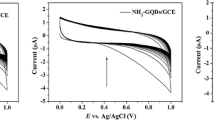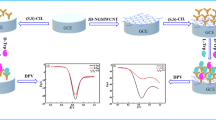Abstract
Electrochemical chiral recognition has gained much of attention as an efficient method for enantiomeric recognition. Herein, a chiral sensing platform via β-cyclodextrin dinuclear copper (Cu-β-CD) as a chiral selector supported on graphene/polypyrrole (RGO/Ppy) nanocomposites were fabricated for recognition of tryptophan (Trp) enantiomers. Cu-β-CD with additional chiral sites improves recognition efficiency, and the addition of the conducting polymer Ppy enhances the electrical conductivity of the nanocomposite and addresses the agglomeration effect of graphene (RGO). In addition, the composition and morphology of the materials were analyzed by transmission electron microscopy (SEM), X-ray diffraction (XRD), Fourier transform infrared spectroscopy (FTIR) and X-ray photoelectron spectroscopy (XPS). The mechanism of chiral recognition was evaluated by water contact angle experiments and UV–Vis absorption spectroscopy. And the battery of chiral recognition experiments revealed that the chiral sensing platform RGO/Ppy/Cu-β-CD/GCE provides excellent recognition of the Trp enantiomer with an enantioselectivity coefficient of 3.24. It also exhibits outstanding stability and reproducibility, with a minimum line of detection (LOD) of 0.37 mM and 1.05 mM for L-Trp and D-Trp, respectively. With these results, the RGO/Ppy/Cu-β-CD/GCE chiral sensing platform has provided a feasible approach for the electrochemical chiral recognition of Trp enantiomers.










Similar content being viewed by others
Data availability
The datasets generated during and/or analyzed during the current study are available from the corresponding author on reasonable request.
References
L.D. Barron. Chemistry, Chirality, magnetism and light. Nature 405(6789), 895 (2000)
E. Zor, H. Bingol, M. Ersoz, Chiral sensors. Trends Anal. Chem. 121, 115662 (2019)
J. Ding, C. Li, Y. Zhang, W. Xu, J. Wang, X. Chen, Chirality-mediated polypeptide micelles for regulated drug delivery. Acta Biomater 11, 346–355 (2015)
C. Wang, E. Wu, X. Wu, X. Xu, G. Zhang, L. Pu, Enantioselective fluorescent recognition in the fluorous phase: enhanced reactivity and expanded chiral recognition. J. Am. Chem. Soc. 137(11), 3747–3750 (2015)
Y. Tao, J. Dai, Y. Kong et al., Temperature-sensitive electrochemical recognition of tryptophan enantiomers based on β-cyclodextrin self-assembled on poly(l-glutamic acid) . Anal. Chem 86(5), 2633–2639 (2014)
H. Xu, Y. Du, Z. Feng, X. Sun, J. Liu, Synthesis of a chiral ionic liquid, cholinium-clindamycin phosphate, as sole chiral selector in capillary electrophoresis. J. Chromatogr. A 1615, 460721 (2019)
S. Carradori, D. Secci, C. Faggi, R. Cirilli, A chromatographic study on the exceptional chiral recognition of 2-(benzylsulfinyl) benzamide by an immobilized-type chiral stationary phase based on cellulose tris (3, 5-dichlorophenylcarbamate). J. Chromatogr. A 1531, 151–156 (2018)
Y.Y. Cui, C.X. Yang, X.P. Yan, Thiol-yne click post-modification for the synthesis of Chiral Microporous Organic Networks for Chiral Gas Chromatography. ACS Appl. Mater. Interfaces 12(4), 4954–4961 (2020)
X. **ao, C. Chen, Y. Zhang et al., Chiral recognition on bare gold surfaces by quartz crystal microbalance. Angew. Chem. Int. Ed. 60, 25028–25033 (2021)
Y.W. Zhao, L.E. Guo, F.Q. Zhang, J. Yao, X.M. Zhang, Turn-on fluorescence enantioselective sensing of hydroxyl carboxylic enantiomers by metal–organic framework nanosheets with a homochiral tetracarboxylate of cyclohexane diamide. ACS Appl. Mater. Interfaces 13(17), 20821–20829 (2021)
J. Tashkhourian, M. Afsharinejad, A.R. Zolghadr, Colorimetric chiral discrimination and determination of S-citalopram based on induced aggregation of gold nanoparticles. Sens. Actuators B 232, 52–59 (2016)
K. Ngamdee, T. Puangmali, T. Tuntulani, W. Ngeontae, Circular dichroism sensor based on cadmium sulfide quantum dots for chiral identification and detection of penicillamine . Anal. Chim. Acta 898, 93–100 (2015)
Y. Zhao, L. Cui, W. Ke, F. Zheng, X. Li, Electroactive Au@Ag nanoparticle assembly driven signal amplification for ultrasensitive chiral recognition of D-/L-Trp . ACS Sustain. Chem. Eng. 7(5), 5157–5166 (2019)
T. Gong, S. Zhu, S. Huang et al., A renewable electrochemical sensor based on a self-assembled framework of chiral molecules for efficient identification of tryptophan isomers. Anal. Chim. Acta 1191, 339276 (2022)
Y. Tao, X. Gu, B. Yang et al., Electrochemical enantioselective recognition in a highly ordered self-assembly framework. Anal. Chem 89(3), 1900–1906 (2017)
C. Pu, Y. Xu, Q. Liu et al., Enantiomers of single chirality nanotube as chiral recognition interface for enhanced electrochemical chiral analysis. Anal. Chem 91(4), 3015–3020 (2019)
X. Niu, X. Yang, H. Li et al., Application of chiral materials in electrochemical sensors. Microchim. Acta 187, 676 (2020)
Q. Han, Q. **a, D. Guo et al., Chiral glutamic acid functionalized graphene: preparation and application. Anal. Methods 7(13), 5387–5390 (2015)
R. Monsef, S.N. Masoud, Electrochemical sensor based on a chitosan-molybdenum vanadate nanocomposite for detection of hydroxychloroquine in biological samples. J. Colloid Interface Sci. 2022 (613): 1–14
J. Zou, X.Q. Chen, G.Q. Zhao et al., A novel electrochemical chiral interface based on the synergistic effect of polysaccharides for the recognition of tyrosine enantiomers. Talanta 195, 628–637 (2019)
J. Song, C. Yang, J. Ma et al., Voltammetric chiral discrimination of tryptophan using a multilayer nanocomposite with implemented amino-modified β-cyclodextrin as recognition element. Microchim. Acta 185(4), 230 (2018)
L. Bao, X. Chen, B. Yang et al., Construction of electrochemical chiral interfaces with integrated polysaccharides via amidation. ACS Appl. Mater. Interfaces 8(33), 21710–21720 (2016)
W. Feng, C. Liu, S. Lu et al., Electrochemical chiral recognition of tryptophan using a glassy carbon electrode modified with β-cyclodextrin and graphene. Microchim. Acta 181, 501–509 (2014)
S.A. Zaidi, Facile and efficient electrochemical enantiomer recognition of phenylalanine using β-cyclodextrin immobilized on reduced graphene oxide. Biosens. Bioelectron. 94, 714–718 (2017)
S.S. Wu, M. Wei, W. Wei et al., Electrochemical aptasensor for aflatoxin B1 based on smart host-guest recognition of β-cyclodextrin. Polym. Biosens. Bioelectron. 129, 58–63 (2019)
M. Yousefi, G. Forozan, G. Davood, S.N. Masoud, Polymeric nanocomposite materials: preparation and characterization of star-shaped PbS nanocrystals and their influence on the thermal stability of acrylonitrile-utadiene-tyrene (ABS) copolymer. Polyhedron. 2011 (30): 1055–1060
Y. Tao, X. Gu, L. Deng et al., Chiral recognition of D-tryptophan by confining high-energy water molecules inside the cavity of copper-modified β-cyclodextrin. J. Phys. Chem. C 119(15), 8183–8190 (2015)
X. Niu, X. Yang, Z. Mo et al., Electrochemical chiral sensing of tryptophan enantiomers by using 3D nitrogen-doped reduced graphene oxide and self-assembled polysaccharides. Microchim. Acta 186, 557 (2019)
X. Yang, X. Niu, Z. Mo et al., Perylene-functionalized graphene sheets modified with chitosan for voltammetric discrimination of tryptophan enantiomers. Microchim. Acta 186(6), 333 (2019)
X. Zeng, K. Zhou, P. Lu, The propagation of the conducting zone of layer-by‐Layer Pani‐RGO composite films. ChemistrySelect 4(32), 9262–9267 (2019)
M. Gandara, E.S. Gonçalves, Electroactive composites: pani electrochemical synthesis with GO and RGO for structural carbon fiber coating. Prog. Org. Coat 138, 105399 (2020)
R. Monsef, S.N. Masoud, Hydrothermal architecture of Cu5V2O10 nanostructures as new electro-sensing catalysts for voltammetric quantification of mefenamic acid in pharmaceuticals and biological samples. Biosens. Bioelectron. 2021 (178): 113017
S.N. Masoud, D. Fatemeh, F. Zeinab, Synthesis and characterization of ZnO nanocrystals from thermolysis of new precursor. Chem. Eng. J. 2009 (146): 498–502
R. **ao, R. Liu, S. Lee et al., Controlled electrochemical synthesis of conductive polymer nanotube structures. J. Am. Chem. Soc 129(14), 4483–4489 (2007)
D. Kumar, R. Sharma, Advance in conductive polymers. Eur. Polymer J 34(8), 1053–1060 (1998)
C. Yu, C. Wang, X. Liu et al., A cytocompatible robust hybrid conducting polymer hydrogel for use in a magnesium battery. Adv. Mater 28(42), 9349–9355 (2016)
C.M. Li, C.Q. Sun, W. Chen et al., Electrochemical thin film deposition of polypyrrole on different substrates. Surf. Coat. Technol. 198(1–3), 474–477 (2005)
Y. Matsui, T. Kurita, Y. Date, Complexes of copper (II) with cyclodextrins. Bull. Chem. Soc. Jpn. 1972(45): 3229–3229
F. Kazemi, Y. Jafarzadeh, S. Masoumi et al., Oil-in-water emulsion separation by PVC membranes embedded with GO-ZnO nanoparticles. J. Environ. Chem. Eng. 9, 104992 (2021)
M.A. Chougule, S.G. Pawar, P.R. Godse et al., Synthesis and characterization of polypyrrole (PPy) thin films. Soft Nanosci. Lett. 1, 6 (2011)
S. Kasisomayajula, N. Jadhav, V.J. Gelling, Conductive polypyrrole and acrylate nanocomposite coatings: mechanistic study on simultaneous photopolymerization. Prog. Org. Coat 101, 440–454 (2016)
J. Li, H. Wang, Z. Qi et al., Kinetics and mechanisms of electrocatalytic hydrodechlorination of diclofenac on Pd-Ni/PPy-rGO/Ni electrodes. Appl. Catal. B 268, 118696 (2020)
S.N. Masoud, M. Shaterian, M.R. Ganjali et al., Oxidation of cyclohexene with tert-butylhydroperoxide catalysted by host (nanocavity of zeolite-Y)/guest (mn (II), Co (II), ni (II) and Cu (II) complexes of N, N′-bis (salicylidene) phenylene-1, 3-diamine) nanocomposite materials (HGNM). J. Mol. Catal. A 261(2), 147–155 (2007)
K. Ghanbari, A. Hajian, Electrochemical characterization of Au/Zno/Ppy/RGO nanocomposite and its application for simultaneous determination of ascorbic acid, epinephrine, and uric acid. J. Electroanal. Chem. 801, 466–479 (2017)
Y. Wang, X. Wu, W. Zhang et al., Synthesis of ferromagnetic sandwich Feco@Graphene@Ppy and enhanced electromagnetic wave absorption properties. J. Magn. Magn. Mater. 443, 358–365 (2017)
X. Gu, Y. Tao, Y. Pan et al., DNA-inspired electrochemical recognition of tryptophan isomers by electrodeposited chitosan and sulfonated chitosan. Anal. Chem. 87(18), 9481–9486 (2015)
H.A. Benesi, J.H.J. Hildebrand, A spectrophotometric investigation of the interaction of iodine with aromatic hydrocarbons. J. Am. Chem. Soc 71, 2703–2707 (1949)
K. Lindner, W. Saenger, β-cyclodextrin dodecahydrate: crowding of water molecules within a hydrophobic cavity. Angew. Chem. Int. Ed. 1978(17): 694–695
Acknowledgements
This work was funded by the National Natural Science Foundation of China (21861034); the Science and Technology Project Gansu Province of China (20YF3GA022); the Natural Science Foundation of Gansu Province of China (18JR3RA094).
Funding
Funding was provided by Science and Technology Program of Gansu Province (20YF3GA022) and Natural Science Foundation of Gansu Province (18JR3RA094).
Author information
Authors and Affiliations
Contributions
ZZ: Writing—original draft, preparation. JW: Experimental operation, data curation. HP: Software, Writing—review and editing. RG: Project administration, software. NL: Software. ZM: Supervision, funding acquisition, writing—review and editing.
Corresponding author
Ethics declarations
Conflict of interest
The authors declare that they have no known competing financial interests or personal relationships that could have appeared to influence the work reported in this paper.
Additional information
Publisher’s Note
Springer Nature remains neutral with regard to jurisdictional claims in published maps and institutional affiliations.
Supplementary Information
Below is the link to the electronic supplementary material.
Rights and permissions
Springer Nature or its licensor (e.g. a society or other partner) holds exclusive rights to this article under a publishing agreement with the author(s) or other rightsholder(s); author self-archiving of the accepted manuscript version of this article is solely governed by the terms of such publishing agreement and applicable law.
About this article
Cite this article
Zhang, Z., Wang, J., Pei, H. et al. β-Cyclodextrin dinuclear copper supported on graphene/polypyrrole nanocomposites as an electrochemical sensor for enantioselectivity recognition of tryptophan enantiomers. J Mater Sci: Mater Electron 34, 989 (2023). https://doi.org/10.1007/s10854-023-10442-6
Received:
Accepted:
Published:
DOI: https://doi.org/10.1007/s10854-023-10442-6




